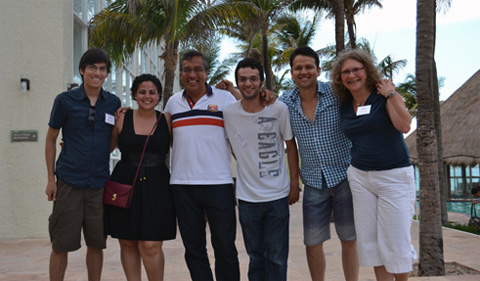By Samantha Peko
The International Workshop on Spintronics and Related Quantum Phenomena (S-60) was held in Cancun, Mexico, from Aug. 7 to 8. The Conference was the brainchild of Ohio University Professor Dr. Saw-Wai Hla, who wanted to honor the 60th birthday of fellow Physics professor Dr. Sergio E. Ulloa.
Ulloa has dedicated his career to the theoretical understanding of spintronic, nanomagnetism and related quantum phenomena. NQPI was proud to sponsor this exciting conference. NQPI, the Nanoscale & Quantum Phenomena Institute, is a an interdisciplinary institute at Ohio University.
Spintronics is an area of physics that manipulates the spin degree of freedom of electrons. Since most electronic devices rely on the electrical charges produced by the electron, this field of research could aid with the development of more powerful and efficient technological devices, and someday a quantum computer.
“This [spintronics] is something that we have not yet exploited in applications too much, and research in this direction continues to bring new ideas, materials and device proposals,” Ulloa said.
The conference brought in researchers from around the world, from Switzerland to Canada. The 40 attendees talked about the future of spintronics, and in the evenings listened to Mariachi and other band performances with the ocean as a backdrop.
One of those attending this conference was Ohio University alum Yong Joe, a professor of Physics at Ball State University, and Sergio’s second graduate student. Joe earned a Ph.D. in Physics from the College of Arts & Sciences in 1992. And what is really interesting is that Joe’s son, Andrew, a physics graduate student at Havard University, also attended and presented a paper at the conference.
Not only did Ulloa mentor a physics student, he created another generation of physics students, said Kay Kemerer, the conference’s co-organizer and NQPI business manager and event coordinator.
For Ulloa, the turnout was a pleasant surprise.
“As for the honor of the event, I was deeply humbled and pleased by the fact that many of my former Ph.D. students and postdocs came to the event, as well as many of my current and former collaborators. It was most pleasurable to hear about their work and discuss it earnestly. It was a lot of fun,” he said.
Poster presentations at the conference addressed problems at the nanoscale, such as spin transport in graphene. Graphene is a material that is incredibly thin yet strong that may be used for smaller electronic devices.
Other attendees at the conference included four Ohio University physics and astronomy professors and many physics and astronomy graduate students.




















Comments